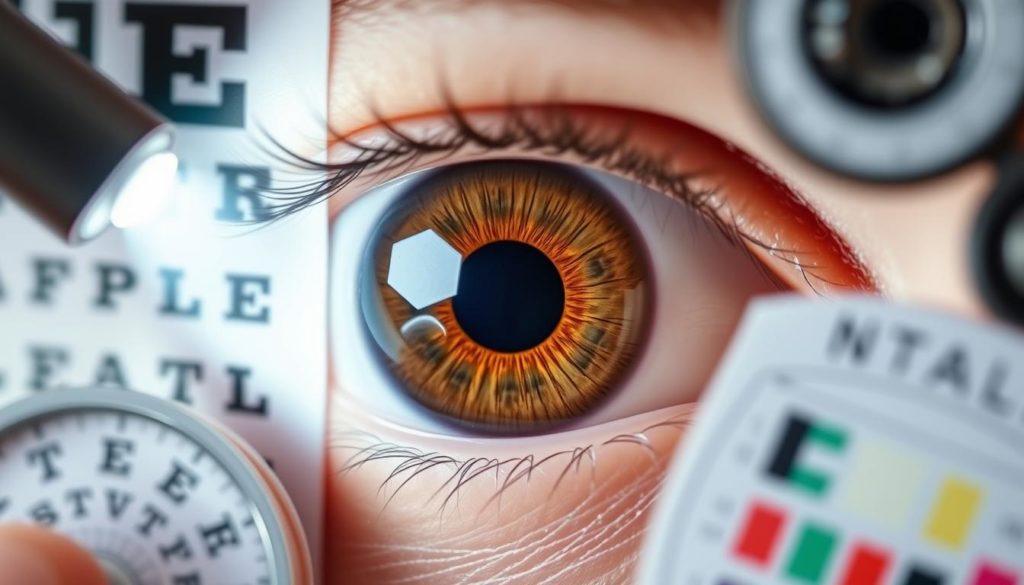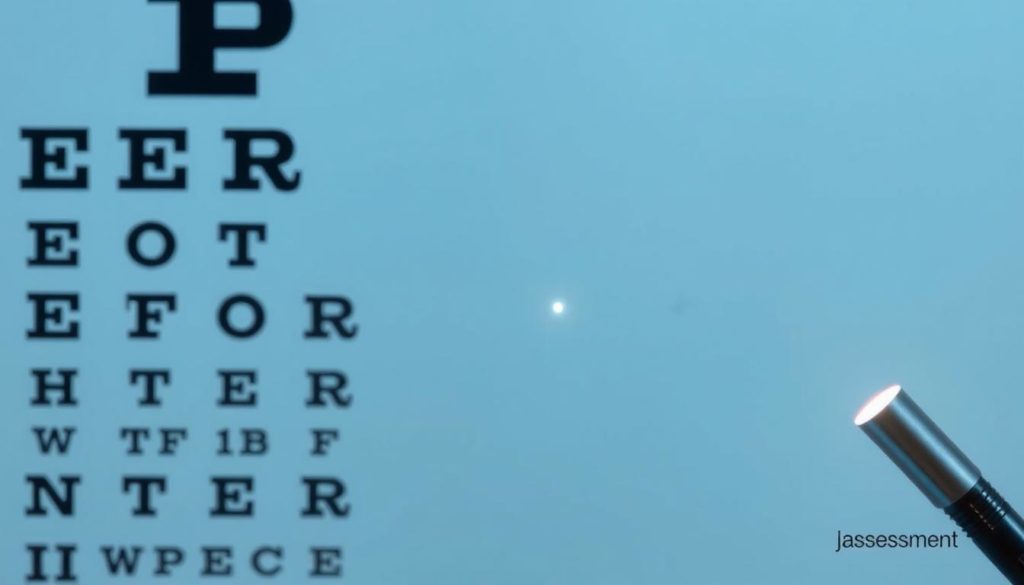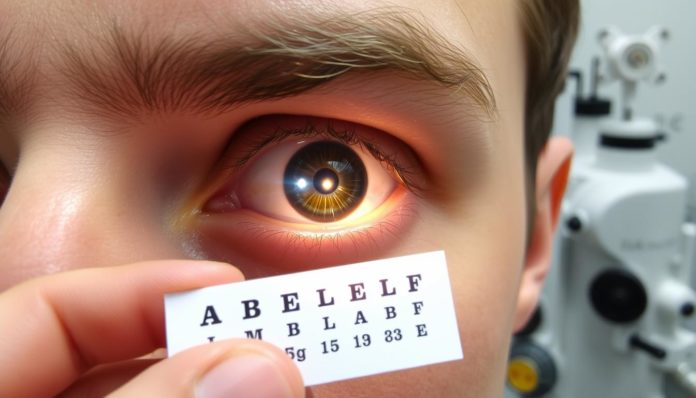Did you know that nearly 10% of neurological consultations involve checking for pupil issues? The PERRLA eye exam is a key tool for quick pupil checks. It’s used by doctors to see how your pupils react to light and changes in distance.
This exam is not just a simple check-up. It’s a way to make sure your eyes are working well and to spot any possible health issues early. If you’re interested in learning more about this test or preparing for your eye exam, you’re in the right spot.
What is a PERRLA Eye Exam?
A PERRLA eye exam is a key test that doesn’t hurt and is used in many medical and eye care settings. It checks how well your pupils work by making sure they are in the right spot, the same size, round, and react to light and focus. Knowing what is PERRLA helps both patients and doctors a lot, as it’s a full check-up for your pupils.
Doctors look for certain signs during the exam that might show there’s a problem. The PERRLA Eye Assessment looks at a few important things to see how healthy your eyes are:
- Positioned properly
- Equal in size
- Round in shape
- Reactive to light
- Light reactivity
- Accommodation

PERRLA eye exams are a big part of checking your eye health. They help find problems linked to eye diseases or brain issues. This test is accurate and easy, helping catch issues early and start treatment right away.
Here’s a simple guide to what the PERRLA exam checks:
| Component | Description |
|---|---|
| Position | Ensuring pupils are aligned equally |
| Equality | Both pupils should be of the same size |
| Roundness | Pupils should be uniformly round |
| Reactivity to Light | Pupils should constrict when exposed to light |
| Light | Pupils should consistently react to light exposure |
| Accommodation | Pupils should adjust appropriately for near and far objects |
The PERRLA Eye Assessment is a detailed and organized way to check your pupils. It’s key for eye health checks, showing its value in spotting problems early.
The Importance of PERRLA in Eye Health Assessment
PERRLA (Pupils Equal, Round, Reactive to Light and Accommodation) is key in eye health checks. It helps doctors spot potential neurological problems and eye diseases early. By watching how pupils react to light and focus, doctors can catch serious issues fast.

Detecting Neurological Conditions
Using PERRLA in eye exams is vital for checking the nervous system. It shows if the pupil reacts oddly, which might mean brain injuries, tumors, or nerve damage. Catching these early can lead to better treatment and outcomes.
Checking for Eye Diseases
PERRLA is also great for spotting vision issues. It helps find problems like anisocoria or glaucoma early. Regular eye checks are key to keeping eyes healthy.
Steps Involved in a PERRLA Eye Exam
The PERRLA eye exam has several important steps for a full pupil check-up. Here’s what happens during these key stages:
Initial Pupil Observation
First, doctors closely watch the pupils’ size, shape, and how they match. This helps spot any oddities early on. It’s a key part of the exam that makes sure later tests are clear and accurate.
Performing the Swinging Flashlight Test
Next up is the swinging flashlight test in the PERRLA exam. A light moves back and forth between the pupils to check how they react to light. This test is key for finding any issues with how the pupils respond to light. It can also hint at neurological problems.
The Accommodation Test
The last step is the accommodation test. It looks at how well the patient can focus on things close and far away. Pupils should get smaller when looking at something close and bigger when looking at something far. This shows the eyes are working right. It’s a crucial part of the exam for a full check-up.
Understanding the Acronym PERRLA
Ever wondered what PERRLA means in an eye exam? It stands for Pupils Equal Round Reactive to Light Accommodation. This term is key in checking your vision. Each letter in the acronym points to a specific part of the pupil check.
- Pupils Equal: This means both pupils are the same size, which is important for good vision.
- Round: The pupils should be round, showing they are healthy and normal.
- Reactive to Light: When light hits the eyes, pupils should get smaller. This shows the brain and eyes are working well together.
- Accommodation: This part checks if pupils get smaller when looking at something close. It shows the eyes can change focus as needed.
The PERRLA meaning is clear when you see how each part is checked during an eye exam. These steps together make sure the eyes are working right. They can spot problems early. Doctors use this tool to understand your eye health fully. If something doesn’t look right, it might mean you need more tests.
Common Conditions Identified by PERRLA Eye Assessment
The PERRLA eye assessment is key in spotting eye issues. It’s vital for doctors, including student nurses, to find problems with pupil size and how they react.
Anisocoria
Anisocoria means one pupil is bigger than the other. The PERRLA exam checks if this size difference is normal or if it points to a bigger issue.
Adie’s Pupil Syndrome
Adie’s Pupil Syndrome shows a slow reaction to light and one big pupil. It’s found during a detailed eye check by student nurses. This leads to more tests to figure out what’s wrong.
Horner’s Syndrome
Horner’s Syndrome has three signs: a small pupil, slow dilation in low light, and a droopy eyelid. Spotting these signs with a PERRLA exam helps doctors treat it fast.
“Early detection of conditions like Anisocoria, Adie’s Pupil Syndrome, and Horner’s Syndrome is critical in providing appropriate and effective medical intervention.”
| Condition | Key Symptoms |
|---|---|
| Anisocoria | Unequal pupil sizes |
| Adie’s Pupil Syndrome | Delayed light reaction, one pupil larger |
| Horner’s Syndrome | Smaller pupil, delayed dilation, drooping eyelid |
In short, PERRLA is key in spotting Anisocoria, Adie’s Pupil Syndrome, and Horner’s Syndrome. It helps doctors make accurate and quick diagnoses.
Preparing for a PERRLA Eye Exam
Before you go for a PERRLA eye exam, knowing what to expect and how to prepare is key. A PERRLA eye exam is vital for routine eye care. It helps spot various conditions early on.
What to Expect During the Exam
Your eye doctor will ask about your eye history before the exam. They might want to know about any vision changes or symptoms you’ve seen. The exam takes place in a dimly lit room to check how your pupils react.
The PERRLA test is quick and doesn’t hurt. Your eyes will be watched as you follow a light source. Knowing what happens during the exam can make you feel more at ease. It’s important to stay calm and focused on the light.
Tips for Accurate Test Results
Here are some tips for getting accurate PERRLA results:
- Eye Examination Preparation: Make sure you know if you should wear your glasses or contact lenses.
- Focus on the Targets: It’s important to watch the targets clearly during the exam.
- Communicate Any Discomfort: If you feel any discomfort, tell your examiner so they can adjust.
By following these tips, you can help get accurate PERRLA results. This makes your eye exam preparation more effective.
Limitations of the PERRLA Test
The PERRLA eye exam is a great first step in checking eye health. But, it has its PERRLA limitations. It mainly looks at how pupils react to light and how they focus. It can hint at possible health issues but can’t say for sure what they are.
A big eye test restriction of the PERRLA test is it can’t measure pupil size or shape well. Small changes in these can mean big health problems. Also, it doesn’t check how fast pupils get bigger or smaller, which is important for checking the nervous system.
Because of these PERRLA limitations, more tests are needed for a full eye check-up. Doctors use other tools to look at pupil size, shape, and how they change. These aren’t covered in a basic PERRLA test.
Let’s dive into what PERRLA can and can’t do, and what’s needed for a full diagnosis:
| Aspect | PERRLA Test | Comprehensive Evaluation |
|---|---|---|
| Pupil Size Measurement | Not Accurate | Precise Measurement |
| Pupil Shape | General Observation | Exact Shape Analysis |
| Reaction to Light | Yes | Yes, plus Response Time |
| Accommodation Response | Yes | Yes, plus Rate of Change |
In short, the PERRLA eye exam is good for a first check-up. But, knowing its limits is key for correct diagnosis and treatment. Using PERRLA along with more detailed tests gives a better look at eye health.
Frequently Asked Questions About PERRLA Testing
The PERRLA eye assessment is a simple test to check how well your eyes work. It’s quick and doesn’t hurt. Here are answers to some common questions about PERRLA testing.
Is the PERRLA Eye Assessment Painful?
No, the PERRLA eye test isn’t painful. Your eye doctor will use a light to look at your pupils. You might feel a bit of discomfort from the light, but it won’t hurt.
How Long Does the Test Take?
The PERRLA test is very short. It usually takes only a few minutes. After it’s done, your doctor will talk to you about the results right away.
Are There Any Side Effects?
There are no long-term side effects from the PERRLA test. Some people might feel a bit uncomfortable because of the bright light. But this discomfort goes away quickly after the test.
Learn more about the PERRLAeye exam.
We hope these answers to PERRLA FAQs help ease any worries you might have. This test is important for your eye health and is not invasive.
The Role of PERRLA in Routine Eye Checkups
The PERRLA eye assessment is key in routine eye checkups. It gives a quick but thorough look at pupil health. This test can show signs of bigger health issues, making it a must-have in eye care.
This test is simple but powerful. It checks if pupils are equal, round, and react to light and focus changes. This helps doctors spot early signs of health problems that might not be caught by regular vision tests. Early action is crucial for staying healthy.
Thanks to new tech, PERRLA is now part of standard eye exams. It ensures tests are consistent and accurate. Whether it’s your first visit or your yearly check-up, the PERRLA test is vital. It helps protect your vision and can reveal broader health concerns. Adding this quick test to your eye care routine is good for your eyes and overall health.
FAQ
Is the PERRLA Eye Assessment Painful?
No, the PERRLA eye assessment is not painful. It involves shining a light into your eyes, which might cause minor discomfort. But it’s not painful. The test is quick and doesn’t hurt.
How Long Does the Test Take?
The PERRLA eye exam is very quick, taking just a few minutes. It’s a simple test done by a healthcare professional. So, it’s fast and easy.
Are There Any Side Effects?
There are no side effects from the PERRLA eye exam. You might feel a bit uncomfortable from the bright light. But, there are no lasting effects.
What Does PERRLA Stand For?
PERRLA stands for Pupils Equal, Round, and Reactive to Light and Accommodation. It’s about checking how your pupils react to light and focus. This helps understand your eye health.
Why is PERRLA Important in Eye Health Assessment?
PERRLA is key because it checks for eye and brain health issues. It looks at how your pupils react to light and focus. Catching problems early with PERRLA means quicker treatment.
What Conditions Can PERRLA Detect?
PERRLA can spot issues like Anisocoria (unequal pupil sizes), Adie’s Pupil Syndrome (slow reaction to light), and Horner’s Syndrome (smaller pupil and droopy eyelid on one side). These need more checks from a doctor.
What Should I Expect During the Exam?
You’ll talk about your eye health and any vision changes with the doctor. The test is done in a dim room. You’ll look at targets while a light checks your pupil reactions.
How Can I Ensure Accurate Test Results?
For accurate results, stay calm and follow the doctor’s instructions. Look at the targets as told and tell the doctor if you feel any discomfort.
Does the PERRLA Test Replace Comprehensive Eye Exams?
The PERRLA test is a quick check but doesn’t replace full eye exams. It’s a first step to spot possible eye and brain issues. If it finds something, you’ll need more detailed tests.


